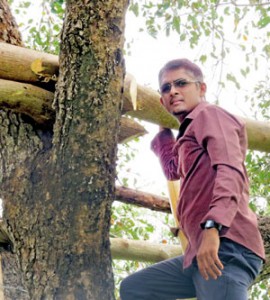Caught! Night raiders who can’t be fenced out
View(s):A 11-month study by research scientist D.G. Ashoka Ranjeewa in a village bordering the Uda Walawe NP reveals interesting behavioural patterns and intellect of elephants. Kumudini Hettiarachchi reports

On camera: Down comes the fence (above) and targetting the post to fell the fence (right)
They came, they saw, they conquered, sometimes through the use of tools, and roamed freely and leisurely in the villages for many hours, before heading back into the National Park (NP).
The electric fence drawn right around the Uda Walawe NP seemed like child’s play for 35 majestic bull-elephants and their intellect. Their modus operandi was ingenious.
The tasty morsels in the villages across the electric fence were tempting. How could they resist the paddy, banana, coconut, mango, manioc, papaya and vegetables, even though the villagers had toiled to cultivate them and were fiercely protective, yelling at them from tree-huts, bombarding them with ali-wedi, lighting up the area with powerful electric torches or huge bonfires and even erecting electric fences.
“The crop-raiders came anyway,” says research scientist D.G. Ashoka Ranjeewa who has been studying wild elephant behaviour at the Uda Walawe NP for a long time and ventured into the electric fence-elephant equation in a ‘first’ such research in the country.
These bull-elephants dubbed ‘problem elephants’ who breached the electric fence, acted alone or in small groups of two to nine. They consisted of 21 mature adults (above 25 years old), five young adults (between 20 and 25 years old) and nine sub-adults (around 10-20 years old). In Ashoka’s research he never came across any cow elephants and their babies roaming the villages.
The bull-elephants would come to the electric fence and the ‘popular’ method of exit through it was either pushing down the fence-posts with their legs or butting them down with their heads. “This would disable the wires carrying the current and allow them to walk across,” says Ashoka, pointing out that they also knew that the posts were free of electricity. The other entry-points the elephants used were the same openings that the villagers used but forgot to put up the spiral wires as night descended.
It was as the evening shadows lengthened from dusk to night, anytime between 6-9 p.m. that these giants of the wild walked into the villages from the NP, restricting the humble men, women and children to their homes and changing their lives. They would make their leisurely way back into the NP anytime between dawn and morning, 4-6 a.m.
Before Ashoka launches into the minute details of his study, he talks of an interesting and intriguing image seared into his mind. A young bull-elephant would swagger along the fence confidently with raised trunk, as if to assess the risks and dangers. Was this bull-elephant checking whether heat was emanating from the electric fence? The answer is yet in the balance, as it has not been substantiated scientifically.
But there are many other elephant-actions including the amazing ‘use of tools’ that he has witnessed while swatting mosquitoes in a tiny hut up in a tree, glancing this way or that from his jeep or peeping through a window of a village home.
“Usually, the only other animals associated with the use of tools are mainly primates such as chimpanzees and orangutans,” points out Ashoka. (See Box)
In an 11-month research in 2014-15 in which he used camera traps to gather scientific data on the elephant crop-raiders of Uda Walawe, he focused on the three ‘border-villages’ of Pokunutenne, Neraluwa and Dahaiyagala along its northern borders.
Ashoka is appreciative of the ready cooperation extended by the Department of Wildlife Conservation (DWC) in granting him permission to conduct the study and the Uda Walawe NP Warden Kalum Pathirana. Wildlife conservationist Ajith Sandanayake, meanwhile, had helped him in data-collection, with valuable inputs from Dr. Prithiviraj Fernando of the Centre for Conservation and Research and former DWC Director-General Dr. Sumith Pilapitiya on designing the study. The Rufford Foundation based in the United Kingdom had funded the research.
While the Uda Walawe NP covers an area of 308sqkm and has a boundary meandering over 100km, it lies contiguous with the Dahaiyagala Sanctuary and the Bogahapattiya Forest Reserve to the north and the Wetahira-Kanda Sanctuary and the Lunugamvehera NP to the east. It is used by around 1,000 elephants and it has been found that their habitat extends beyond its boundaries and covers adjacent conservation and non-conservation areas.
Kauda gam walata panina alior who are the elephant-raiders was the question to which Ashoka was seeking answers, along with how many are doing so and how they are overcoming the obstacle that looms ahead of them — the electric fence that the DWC has erected to dissuade them. It runs through small forest patches in some places, while several public roads cross it in the Dahaiyagala Sanctuary. The fence also has entry points, protected by detachable electric wires linked to the roads.

Ashoka constructing a tree hut
The elephants’ favourite haunt is Pokunutenne, home to about 100 families. As such, Ashoka had selected a two-km stretch of fence between Pokunutenne and the NP, tracing the permanent footpaths of the elephants. Having found the breaches easily, it was at these spots that he fixed infra-red night vision camera traps, not to ‘catch’ the elephants, just their images.
The person tasked with maintaining the fence, Premalal of the Civil Defence Force who accompanied him would quickly repair the breaches. In the night, from 5.30 p.m. to 6.30 a.m. the next day, Ashoka would trek the same path checking the voltage emanating from the electric fence. The voltage is meant to give elephants a shock to deter them from crossing but not injure or kill them. He would also spend many a night in the village-homes, keeping watch.
This two-km stretch had been earmarked into two segments by Ashoka – a one-km ‘ecological’ fence separating the NP from the village and the other a one-km ‘administrative’ fence which runs through a patch of forest which is part of the village, just outside the NP boundary.
Next morning he would go back along the same fence and check how many posts had been toppled by the elephants and in what direction, whether away from or towards the NP to check their crossing patterns and also whether damage had been caused to the wires.
In the early days of his research, he had found that the voltage along the fence was not regulated and the elephants were crossing to both sides at will. However, even after the DWC installed a new unit early last year and the voltage was regulated, the elephants were still breaching this protective measure by toppling the posts.
When next the wire carrying the electricity was wound around the posts, the ‘elephant breakthroughs’ had indeed dwindled along that stretch, with posts along other stretches becoming their target.
| Masters at adaptation The street-smart bull elephants of Uda Walawe simply adapted when a novel idea was implemented to draw the top wire of the electric fence forward from the post to prevent them from reaching the post, with the middle wire being neutral and the bottom wire in its usual place. Soon after implementation, huge sighs of relief had followed, after the thrill of observation that the breaching-problem had finally got a permanent solution. Humans, however, had not contended with behavioural changes in the elephants to meet this contingency. “This was a measure to prevent the elephants from getting access to the post,” says Ashoka, smilingly describing how they simply ‘adapted’ to the challenge. The elephants resorted to a new trend, for they were found in the village during the night and for Ashoka it is still a mystery how they got there. While Ashoka had been trying to unravel this mystery, suddenly the elephants once again adapted their behaviour – reaction following action. They would amble up to the fence and as if they had taken a distance-measurement, kick a small tree well within reach of the fence, to fall onto the fence and fell it. “Elephants have been known to use tree branches as fly-swatters but this was unique behaviour for them, the use of tools,” says Ashoka. Here the elephants had realized that if they topple trees onto the fence, the wires would come down. They had estimated the distance of the trees from the fence and whether they would fall on the fence, for there had been no record of trees being brought from far away. “Yes,” he smiles, when asked whether he knows the elephants individually. He is able to identify at least 700 in the NP with ease, having looked at their body-shape, ears and tails, photographed them and fused them into a catalogue. Ashoka has two favourites among the 35 who walk around Pokunutenne like the masters of all they survey. They are No. 155 and No. 186, he says, adding that 155 has a devil-may-care attitude, loitering in the village for about 12 hours and ready to take risks.
|
| ‘Ecological’ fence better bet The ‘administrative’ fence faces more damage than the ‘ecological’ fence, Ashoka’s research has determined, making the location of the fence critical. This is because people are seen and engage in activity close to the ‘ecological’ fence and if there is any damage they repair it quickly. This seems a good deterrent against breaching. There is also a behavioural change among the villagers when they feel that the fence is not reliable, according to Ashoka. Pel rakinawa, nidi maranawa, he says, pointing out that they are up the whole night in attempts to protect their crops. They are also like prisoners in their own homes, unable to leave their cultivations for a single night. Explaining that in 2013, there were very few private electric fences, he says that now almost all village homes have a locally-made electric fence around their properties, which is about 98% successful in keeping wild elephants at bay. The most probable conclusion that could be drawn from this is that as in other areas of the country, it seems that community-run village electric fences may work around Uda Walawe too, while the DWC fence seems to be clearly entangled in trouble in the elephant-breaching issue. |


